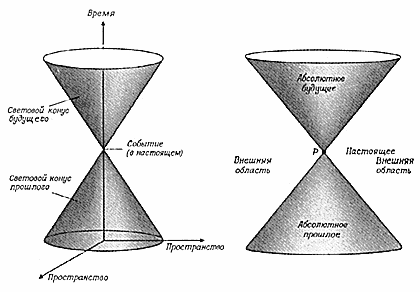Answer the question
In order to leave comments, you need to log in
Fragment from the book "A Brief History of Time"?
I'm reading A Brief History of Time by Stephen Hawking.
Some moments are quite difficult for me, I have to re-read a lot of time, despite the sci-pop genre, but I expected this.
One of the difficulties was this picture 
. Could you explain it to me in a rather simple way? And here is the light and the event, where does the past, why exactly the cone, and indeed what is it, lol.
Here is the explanation given in the book:
Similarly, light, propagating from some
event in four-dimensional space-time, forms a three-dimensional cone in it. This
cone is called the future light cone for the given event. You can draw
another cone, which is called the light cone of the past and represents a set
of events from which the light pulse can hit the point corresponding to this
event (1 picture).
The light cones of the past and the future for a given event P divide space-
time into three regions (picture 2). The absolute future of a given event is the area
contained within the light cone of the future event P. This is the totality of all events,
which, in principle, can be affected by what happens at point P. Events lying outside
the light cone of an event P are unreachable for signals coming from point P, since nothing
can travel faster than light. Consequently, they are not affected in any way by what is happening at
the point P. The absolute past event P lies inside the light cone of the past. This is
the set of all events, the signals from which, propagating at the speed of light or
at a lower speed, can get to point P. Thus, the past cone contains the
set of all events that can affect the event at point P. Knowing what happens at
what is a moment of time everywhere in that region of space that is limited by light
the cone of the past event P, one can predict what should happen at the point P itself.
The region of space that does not lie inside the light cones of the past and the future, we
will call external. The events belonging to the outer region cannot themselves
influence the events at the point P, nor can they be influenced by the events occurring in P.
Answer the question
In order to leave comments, you need to log in
A cone is a model of an expanding 2D universe.
The vertical axis is time. Plus 2 directions within such a universe.
The vanishing point is the big bang. It is assumed that everything at that time was at one point.
Starting from time 0, space expands. That. If you take any point inside the cone at time t, then check through it the line from point 0, you can determine its position at any time T. Thus. it is clear that the universe is expanding, like a rubber trampoline that is constantly stretched.
The cone at the bottom is supposed to be the previous universe that sanitized to a point.
------- Well, in general, I didn’t read about the light cone :)
With regards to the light cone, about the same. At time 0, a beam of light (an event) is generated at point P. the highest speed of information propagation is the speed of light, then the cone is a three-dimensional front of light (information) propagation in space. If you draw a horizontal plane after any time T, you will see a round area where it is known that the beam has ignited (an event has occurred), in the rest of the area the presence of an event is not known to the observer.
The closest analogy is a wave from a thrown stone in stagnant water, when the wave front increases and increases, taking away information about the thrown stone further and further with time.
This is the author's vision, therefore it is painted with cones.
Why light? Because light is the fastest thing in the world. And it is believed that, at such a speed, time is stretched or clamped. This shows that time is not the same everywhere, somewhere it is faster, but somewhere slower.
Didn't find what you were looking for?
Ask your questionAsk a Question
731 491 924 answers to any question